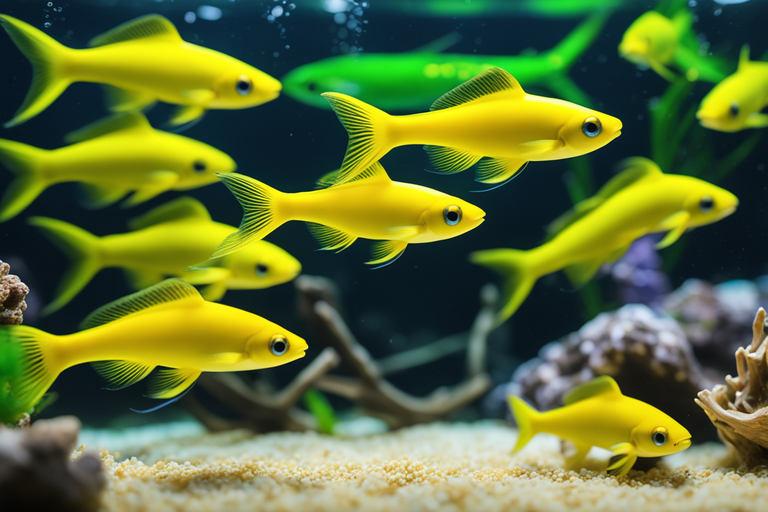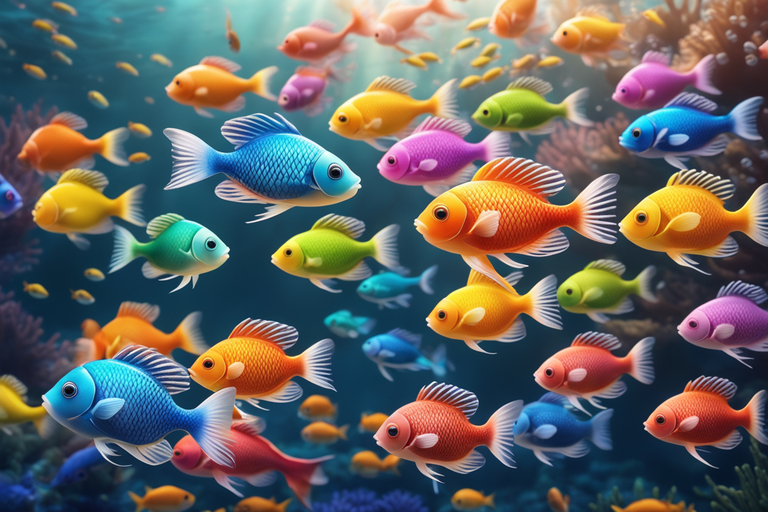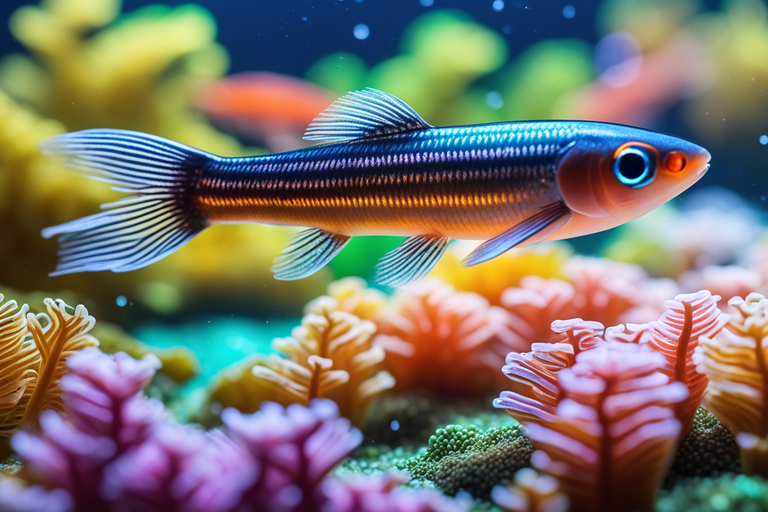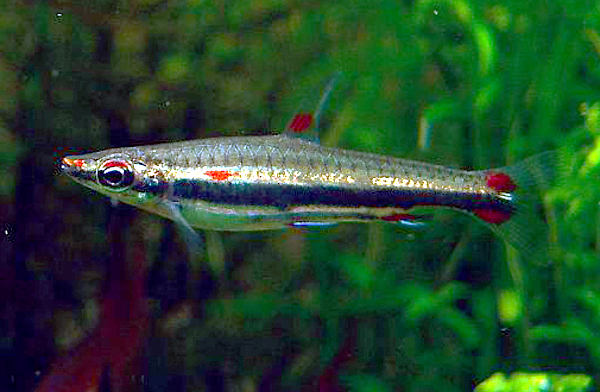Dwarf Pencilfish (Nannostomus Marginatus) are an ideal addition to any aquarium due to their peaceful nature, unique appearance, and ease of care.
These small, peaceful fish are native to the tropical waters of South America and can reach up to 2 inches in size.
Dwarf Pencilfish are a great choice for both beginner and experienced aquarists due to their low maintenance requirements and ability to thrive in a variety of water conditions.
This guide will provide detailed information on their diet, tank requirements, tank mates, and breeding.
Overview and Quick facts
Here are some quick facts about the Dwarf Pencilfish:
- Species: The Dwarf Pencilfish (Nannostomus marginatus) is a small freshwater fish species that typically grows to around 1.5 inches (3.8 cm) in length2. It is the smallest member of its species1.
- Tank Size: A minimum tank size of 10 gallons is recommended for a small group of Dwarf Pencilfish1. They are peaceful fish and can be kept in small groups or as a single specimen in a community tank2.
- Water Conditions: Dwarf Pencilfish are adaptable to a wide range of water parameters, making them suitable for various tank setups4. They prefer slightly acidic to neutral water with a pH range of 6.0-7.5 and a temperature range of 72-82°F (22-28°C)4.
- Tank Mates: Dwarf Pencilfish are peaceful and can be kept with other small, non-aggressive fish4. They occupy the top portion of the aquarium, so they can coexist with bottom-dwelling species like Corydoras catfish4.
- Diet: In the wild, Dwarf Pencilfish feed on small invertebrates and plankton5. In the aquarium, they should be fed a varied diet of high-quality flakes, small pellets, and live or frozen foods such as brine shrimp and daphnia4.
- Behavior: Dwarf Pencilfish are calm, shy, and sociable fish3. They are relatively passive during the day but become more active in the evening3. They are fast swimmers and may dart around the tank when startled3.
- Breeding: Breeding Dwarf Pencilfish can be challenging, and they are not commonly bred in captivity6. They are appreciated for their slender body shape and peaceful nature, making them a popular choice for planted community tanks1.
Frequently overlooked as an aquarium fish, Dwarf Pencilfish are a unique and fascinating species that make an ideal addition to any aquascape. They are known for their peaceful nature, making them an especially attractive choice for any aquarium that has to house multiple species of fish.

Dwarf Pencilfish can reach up to two inches in size, and they prefer a sandy substrate and plenty of cover available in the form of plants or rocks. It’s important to keep Dwarf Pencilfish in a well-maintained tank to ensure their health and well-being. Regular tank cleaning and water changes are essential to keeping peace in the tank.
The ideal water temperature range for Dwarf Pencilfish is between 74 to 81 degrees Fahrenheit, with a pH of 6 to 7.5. They also require a moderate water flow and plenty of oxygen. As omnivores, Dwarf Pencilfish will accept a variety of foods, including flakes, pellets, frozen foods, live food, and even vegetables.
Dwarf Pencilfish are a unique fish that will bring color and activity to any tank, and with the right care they can live for up to four years.
Appearance & Behavior
Dwarf Pencilfish have a unique appearance and behavior that can add a lot of activity and color to any aquarium. The morphology of the Dwarf Pencilfish features an elongated, slender body, with a short snout and a laterally compressed abdomen. The coloration varies, but usually consists of a pale yellow-green to a dark olive-grey, with a light band running along both sides of the body and a dark spot on the caudal peduncle.
They are a schooling fish, and it is important to keep at least five individuals in the same aquarium to avoid stress. They are generally peaceful and will not bother other tank mates, however they can be timid and skittish if not provided with plenty of cover and hiding spots. Dwarf Pencilfish are also known to communicate through body language, and will often display a quivering behavior when they sense danger.
When kept in a healthy environment, Dwarf Pencilfish can be very active, swimming throughout the tank in search of food. They can also be found socializing with other members of the school, often forming a tight group when threatened. With proper care, Dwarf Pencilfish can be a great addition to any community aquarium.
Lifespan
When provided with proper care, Dwarf Pencilfish can have a lifespan of up to five years. To ensure a long and healthy life for these fish, there are several important factors to consider:
- Building Bonds: Dwarf Pencilfish are highly social creatures, and they need the companionship of other fish in order to stay healthy and active. A small shoal of at least six fish is recommended to help them feel secure and to encourage socializing.
- Tank Decorations: Providing a tank with plenty of hiding places and decorations will help your Dwarf Pencilfish explore their environment and feel safe. Rocks, artificial plants, and driftwood are all great additions to their tank.
- Socializing: Allowing your fish to interact with each other is essential for their mental and physical wellbeing. Encouraging them to mingle and play with their tank mates will create strong bonds and help them stay happy and healthy.
- Diet: Feeding Dwarf Pencilfish a balanced diet of high-quality flakes or pellets will help them live a long and healthy life. Variety is important, so make sure to provide a wide range of foods.
By following these tips, you can ensure that your Dwarf Pencilfish have a long and healthy life.
Now, let’s move on to discuss the care and tank requirements for these delightful little fish.
Care and tank requirements
When it comes to caring for Dwarf Pencilfish, the tank requirements and care procedure are essential for their overall health and wellbeing. When choosing a tank, it is important to consider the size of the tank, the type of filter, the type of substrate that is used, and the number of fish being kept in the tank.
The tank should be at least 10 gallons, with an undergravel filter, and a fine-grained, sandy substrate. Keeping the tank at a temperature of 73-82°F is ideal for the fish.
In addition to the tank requirements, it is important to maintain the water in the tank and keep it clean. This can be done by changing the water weekly and performing regular water tests to monitor the water parameters, such as pH, ammonia, and nitrates. The water should also be filtered and oxygenated regularly.
It is also important to properly feed the Dwarf Pencilfish. They are omnivores and will eat a variety of live and frozen foods, such as brine shrimp, daphnia, bloodworms, and tubifex. It is important to feed the fish two to three times a day, in small amounts.
Tank Mates

Dwarf Pencilfish (Nannostomus marginatus) are peaceful and timid fish that thrive in well-decorated tanks with plenty of hiding spots, such as those with plants and submerged driftwood. They are best suited to living with other docile and relatively mellow tank mates, as they tend to hide when housed with boisterous or aggressive fish1. Suitable tank mates for Dwarf Pencilfish include:
- Tetras: Tetras are peaceful, colorful, and display schooling behavior, making them a good choice for sharing a tank with Dwarf Pencilfish2.
- Corydoras: Corydoras are another peaceful option and they can be paired with Tetras and Rasboras as tank mates3.
- Rasboras: Like Corydoras, Rasboras are peaceful and can be housed with Dwarf Pencilfish4.
- Apistogrammas (Dwarf Cichlids): Apistogrammas are also excellent tank mates as they can make shyer species feel less isolated3.
- Betta Fish: Some hobbyists have successfully kept Betta Fish with Dwarf Pencilfish, although caution is advised as Bettas can sometimes be aggressive4.
When considering tank mates for Dwarf Pencilfish, it’s important to ensure that the other species are not only peaceful but also compatible in terms of water parameters and environmental needs.
Diet and Feeding

Proper diet and feeding is essential for keeping Dwarf Pencilfish healthy. These omnivorous fish are opportunistic feeders and will eat most foods offered in their tank. When selecting food, it’s important to provide a variety of proteins, such as insect larvae, bloodworms, and brine shrimp, as well as vegetable options like algae wafers, blanched spinach, and zucchini. To maintain a balanced nutrient diet, provide a combination of frozen and live foods that are small enough for the pencilfish to consume.
When feeding, it’s best to offer small amounts several times a day. This will help prevent overfeeding and ensure the fish have access to enough food. Additionally, avoid leaving leftover food in the tank for too long, as it can lead to water quality issues.
Adding fresh vegetables to the tank for grazing will help provide a nutrient balance. To keep Dwarf Pencilfish happy and healthy, make sure to provide a balanced diet that includes both proteins and vegetables. By following these guidelines and offering small amounts of food several times a day, you can ensure that your fish receive the nutrients they need.
Breeding
Breeding Dwarf Pencilfish can be a rewarding experience, but it requires careful planning and preparation. To successfully breed Dwarf Pencilfish, owners must first identify a healthy male and female in their aquarium. It is important that the fish be of similar size and age to maximize the chances of a successful breeding process. As the fish enter into breeding condition they will display different behaviors, such as displaying of fins and chasing.
Once the couple is identified, they should be moved to a separate breeding tank. The tank should be heated to 82°F and decorated with plenty of plants and hiding spaces. The water should also be slightly acidic in order to replicate their natural environment.
The breeding process involves the male courting the female and ultimately depositing eggs. After the eggs are laid, the parents should be removed from the tank to prevent them from eating the eggs. The eggs will incubate for approximately five days, after which the fry will hatch.
To ensure the success of the breeding process, the tank should be kept clean and free of any parasites or diseases. Regular water changes should be done to maintain the water quality and to provide the fry with a healthy environment. Feeding the fry with newly hatched brine shrimp or other fine food will also be necessary.

